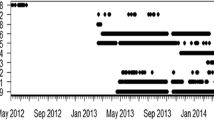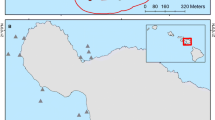Abstract
Empirical data quantifying the long-term movement patterns of coral reef top predators are needed in order to design marine protected areas (MPAs) that will provide these fishes with effective, long-term protection. Acoustic telemetry was used to quantify the movements of a large coral reef top predator (Aprion virescens, Lutjanidae; Hawaiian name ‘uku’) at five atolls in the Northwestern Hawaiian Islands Marine National Monument (NWHIMNM) from May 2005 to September 2006. The study atolls were located between 23.8°N, 166.2°W and 28.5°N, 178.3°W, and were separated from their nearest receiver-equipped neighbor by distances ranging from 100 to 478 km. No inter-atoll movements by uku were detected but individuals were seasonally site-attached to core activity areas of up to 12 km in length, and ranged up to 19 km across atolls. Within their core areas, tagged uku exhibited diel and tidal habitat shifts, with the latter resulting in round trips of up to 24 km in 24 h. Seasonal uku migrations resulted in extended winter (October–April) absences from summer (May–September) core activity areas and may be linked to summer spawning. Large MPAs (i.e., entire islands, atolls or banks) would probably be required for full protection of resident populations of adult uku, but such ‘island-scale’ MPAs will not benefit fisheries unless there is significant larval supply from MPAs to neighboring fished areas, or adult emigration over time scales exceeding the 16-month monitoring period of this study. A mixed management strategy of combining smaller MPAs with conventional measures (e.g., minimum size limits, catch, and effort restrictions) may be the best approach for sustaining uku fisheries. However, this would still require relatively large MPAs (12 km in length) to contain uku short-term (diel and tidal) movements, and seasonal migrations would still take uku beyond the boundaries of MPAs of this size. These fluxes across MPA boundaries could supply fish to fisheries but, if high exploitation rates exist, fishing could eliminate key MPA benefits such as increased numbers of large, highly fecund individuals.






Similar content being viewed by others
References
Agardy T, Bridgewater P, Crosby MP, Day J, Dayton PK, Kenchington R, Laffoley D, McConney P, Murray PA, Parks JE, Peau L (2003) Dangerous targets? Unresolved issues and ideological clashes around marine protected areas. Aquat Conserv Mar Freshw Ecosyst 13:353–367
Arendt MD, Lucy JA, Munroe TA (2001) Seasonal occurrence and site-utilization patterns of adult tautog, Tautoga onitis (Labridae), at manmade and natural structures in lower Chesapeake Bay. Fish Bull 99:519–527
Chatfield C (1996) The analysis of time series an introduction, 5th edn. Chapman and Hall, Boca Raton
Cocklin C, Craw M, McAuley I (1998) Marine reserves in New Zealand: use rights, public attitudes and social impacts. Coast Manage 26:213–231
DeMartini EE (1993) Modeling the potential of fishery reserves for managing Pacific coral reef fishes. Fish Bull 91:414–427
DeMartini EE, Friedlander AM (2004) Spatial patterns of endemism in shallow-water reef fish populations of the Northwestern Hawaiian Islands. Mar Ecol Prog Ser 271:281–296
DeMartini EE, Friedlander AM, Holzwarth SR (2005) Size at sex change in protogynous labroids, prey body size distributions, and apex predator densities at NW Hawaiian atolls. Mar Ecol Prog Ser 297:259–271
Domeier ML, Colin PL (1997) Tropical reef fish spawning aggregations: defined and reviewed. Bull Mar Sci 60:698–726
Everson AR, Williams HA, Ito BM (1989) Maturation and reproduction in two Hawaiian eteline snappers, uku, Aprion virescens, and onaga, Etelis coruscans. Fish Bull 87:877–888
Friedlander AM, DeMartini EE (2002) Contrasts in density, size, and biomass of reef fishes between the Northwestern and the main Hawaiian Islands: the effects of fishing down apex predators. Mar Ecol Prog Ser 230:253–264
Gerber LR, Heppell SS, Ballantyne F, Sala E (2005) The role of dispersal and demography in determining the efficacy of marine reserves. Can J Fish Aquat Sci 62:863–871
Haight WR, Kobayashi DR, Kawamoto DE (1993a) Biology and management of deepwater snappers of the Hawaiian Archipelago. Mar Fish Rev 55:20–27
Haight WR, Parrish JD, Hayes TA (1993b) Feeding ecology of deepwater lutjanid snappers at Penguin Bank, Hawaii. Trans Amer Fish Soc 122:328–347
Halpern BS (2003) The impact of marine reserves: do reserves work and does reserve size matter? Ecol Appl 13:S117–S137
Hartill BW, Morrison MA, Smith MD, Boubée J, Parsons DM (2003) Diurnal and tidal movements of snapper (Pagrus auratus, Sparidae) in an estuarine environment. Mar Fresh Res 54:931–940
Heyman WD, Kjerfve B, Graham RT, Rhodes KL, Garbutt L (2005) Spawning aggregations of Lutjanus cyanopterus (Cuvier) on the belize barrier reef over a 6 year period. J Fish Biol 67:83–101
Holland KN, Peterson JD, Lowe CG, Wetherbee BM (1993) Movements, distribution and growth rates of the white goatfish Mulloides flavolineatus in a fisheries conservation zone. Bull Mar Sci 52:982–992
Holland KN, Lowe CG, Wetherbee BM (1996) Movements and dispersal patterns of blue trevally (Caranx melampygus) in a fisheries conservation zone. Fish Res 25:279–292
Hughes TP (1994) Catastrophes, phase shifts, and large-scale degradation of a Caribbean coral reef. Science 265:1547–1551
Jennings S, Lock JM (1996) Population and ecosystem effects of fishing. In: Polunin NVC, Roberts CM (eds) Reef fisheries. Chapman and Hall, London, pp 193–218
Jennings S, Reynolds JD, Polunin NVC (1999) Predicting the vulnerability of tropical reef fishes to exploitation with phylogenies and life histories. Conserv Biol 13:1466–1475
Kelley C, Ikehara W (2006) The impacts of bottomfishing on Raita and west St. Rogatien banks in the Northwestern Hawaiian Islands. Atoll Res Bull 543:305–317
Kramer DL, Chapman MR (1999) Implications of fish home range size and relocation for marine reserve function. Environ Biol Fish 55:65–79
Kuiter RH, Tonozuka T (2001) Pictorial guide to Indonesian reef fishes. Part 1. Eels—Snappers, Muraenidae—Lutjanidae. Zoonetics, Australia
Lindholm J, Kaufman L, Miller S, Wagschal A, Newville M (2005) Movement of yellowtail snapper (Ocyurus chrysurus Block 1790) and black grouper (Mycteroperca bonaci Poey 1860) in the Northern Florida keys national marine sanctuary as determined by acoustic telemetry. Marine sanctuaries conservation series MSD-05-4. US Department of Commerce, National Oceanic and Atmospheric Administration, Marine Sanctuaries Division, Silver Spring, MD
Lieske E, Myers R (1994) Collins pocket guide. Coral reef fishes. Indo-Pacific and Caribbean including the Red Sea. HarperCollins, New York
Lowe CG, Wetherbee BM, Meyer CG (2006) Using acoustic telemetry monitoring techniques to quantify movement patterns and site fidelity of sharks and giant trevally around french frigate shoals and midway atoll. Atoll Res Bull 543:281–303
Meyer CG (2003) An empirical evaluation of the design and function of a small marine reserve (Waikiki marine life conservation district). Doctoral dissertation, Zoology Department, University of Hawaii at Manoa
Meyer CG, Holland KN (2005) Movement patterns, home range size and habitat utilization of the bluespine unicornfish, Naso unicornis (Acanthuridae) in a Hawaiian marine reserve. Environ Biol Fish 134:602–606
Meyer CG, Honebrink R (2005) Retention of surgically implanted transmitters by bluefin trevally (Caranx melampygus). Implications for long-term movement studies. Trans Amer Fish Soc 134:602–606
Meyer CG, Holland KN, Wetherbee BM, Lowe CG (2000) Movement patterns, habitat utilization, home range size and site fidelity of whitesaddle goatfish, Parupeneus porphyreus, in a marine reserve. Environ Biol Fish 59:235–242
Meyer CG, Holland KN, Papastamatiou YP (in press) Seasonal and diel movements of giant trevally (Caranx ignobilis) at remote Hawaiian atolls: implications for the design of marine protected areas. Mar Ecol Prog Ser
Moffitt RB, Kobayashi DR, DiNardo GT (2006) Status of the Hawaiian bottomfish stocks, 2004. Pacific Islands Fish Sci Cent, Natl Mar Fish Serv, NOAA, Honolulu, HI 96822-2396. Pacific Islands Fish Sci Cent Administrative Report H-06-01
Nowlis JS, Roberts CM (1999) Fisheries benefits and optimal design of marine reserves. Fish Bull 97:604–616
Ogden JC, Buckman NS (1973) Movements, foraging groups, and diurnal migrations of the striped parrotfish Scarus criosensis Bloch (Scaridae). Ecology 54:589–596
Pace ML, Cole JJ, Carpenter SR, Kitchell JF (1999) Trophic cascades revealed in diverse ecosystems. Trends Ecol Evol 14:483–488
Pauly D, Christensen V, Guénette S, Pitcher TJ, Sumaila UR, Walters CJ, Watson R, Zeller D (2002) Towards sustainability in world fisheries. Nature 418:683–695
Peabody MB (2004) The fidelity of red snapper (Lutjanus campechanus) to petroleum platforms and artificial reefs in the Northern Gulf of Mexico. Masters thesis, department of oceanography and coastal sciences, Louisiana State University
Polovina JJ (1984) Model of a coral reef ecosystem. Coral Reefs 3:1–11
Randall JE (1996) Shore fishes of Hawaii. Natural World Press, Vida, OR
Righton D, Miller M, Ormond R (1998) Correlates of territory size in the butterflyfish Chaetodon austriacus (Rueppell). J Exp Mar Biol Ecol 226:183–193
Roberts CM, Polunin NVC (1993) Marine reserves: simple solutions to managing complex fisheries? Ambio 22:363–368
Russ GR (2002) Yet another review of marine reserves as reef fishery management tools. In: Sale PF (ed) Coral reef fishes: dynamics and diversity in a complex ecosystem. Academic, London, pp 421–433
Russ GR, Alcala AC, Maypa AP, Calumpong HP, White AT (2004) Marine reserve benefits local fisheries. Ecol Appl 14:597–606
Sadovy Y, Kulbicki M, Labrosse P, Letourneur Y, Lokani P, Donaldson TJ (2003) The humphead wrasse, Cheilinus undulatus: synopsis of a threatened and poorly known giant coral reef fish. Rev Fish Biol Fish 13:327–364
Sokal RR, Rohlf FJ (1995) Biometry: the principles and practice of statistics in biological research. W. H. Freeman Company, New York
Sommer C, Schneider W, Poutiers JM (1996) FAO species identification field guide for fishery purposes. The living marine resources of Somalia. FAO, Rome
Stevens JD, Bonfil R, Dulvy NK, Walker PA (2000) The effects of fishing on sharks, rays, and chimaeras (chondrichthyans), and the implications for marine ecosystems. ICES J Mar Sci 57:476–494
Sudekum AE, Parrish JD, Radtke RL, Ralston S (1991) Life history and ecology of large jacks in undisturbed, shallow, oceanic communities. Fish Bull 89:493–513
Wolfenden J, Cram F, Kirkwood B (1994) Marine reserves in New Zealand: a survey of community reactions. Ocean Coast Manage 25:31–51
Zeller DC (1997) Home range and activity patterns of the coral trout Plectropomus leopardus (Serranidae). Mar Ecol Prog Ser 154:65–77
Acknowledgments
We thank the crew of the NOAA ship Hi’ialakai especially coxswains M. Gordon, G. Maurizio, J. Kehn, and S. Jones for scientific mission support. We thank R. Kosaki, B. Bowen, M. Craig, J. Zamzow, and P. Santos for their assistance in the field. We thank R. Brainard (NOAA Pacific Islands Fisheries Science Center, Coral Reef Ecosystem Division) for providing us with berths on the September 2006 NWHIMNM research and monitoring cruise. We are grateful to J. Gove, D. Merrit, and E. Lundblad for assistance with generating tidal curves for PHR. This study was funded by an award to Hawaii Institute of Marine Biology from the National Marine Sanctuary Program (MOA 2005-008/6882). This work was carried out in accordance with the animal use protocols of the University of Hawaii (protocol No. 05-053). This work was conducted under NOAA-NWHICRER permit No. 2005-010, NOAA- NWHIMNM- permit No. 2006-012, US Fish and Wildlife Special Use Permits No. 12521-05020, No. 12521-06021, and No. 12521-06048, and State of Hawaii Department of Land and Natural Resources permits No. DLNR.NWHI06R003 and No. DLNR.NWHI06R019. The experiments carried out during this study complied with the current laws of the USA.
Author information
Authors and Affiliations
Corresponding author
Additional information
Communicated by J.P. Grassle.
Electronic supplementary material
Below is the link to the electronic supplementary material.
Rights and permissions
About this article
Cite this article
Meyer, C.G., Papastamatiou, Y.P. & Holland, K.N. Seasonal, diel, and tidal movements of green jobfish (Aprion virescens, Lutjanidae) at remote Hawaiian atolls: implications for marine protected area design. Mar Biol 151, 2133–2143 (2007). https://doi.org/10.1007/s00227-007-0647-7
Received:
Accepted:
Published:
Issue Date:
DOI: https://doi.org/10.1007/s00227-007-0647-7




